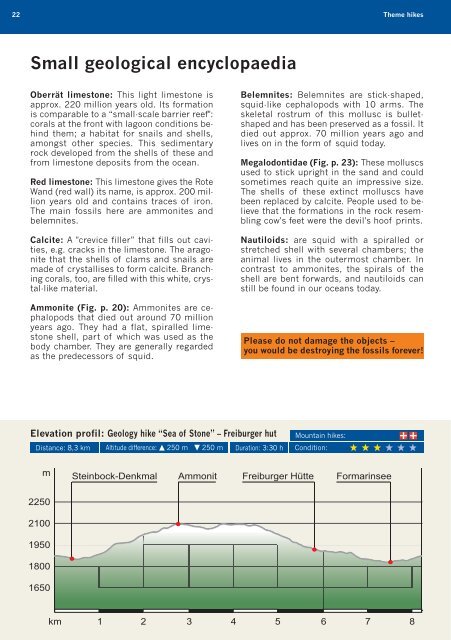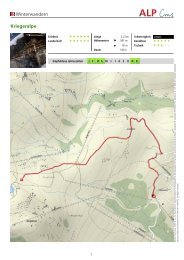Lech-Zürs - Worlds of hiking
Lech-Zürs - Worlds of hiking
Lech-Zürs - Worlds of hiking
Create successful ePaper yourself
Turn your PDF publications into a flip-book with our unique Google optimized e-Paper software.
22 Theme hikes<br />
Small geological encyclopaedia<br />
Oberrät limestone: This light limestone is<br />
approx. 220 million years old. Its formation<br />
is comparable to a “small-scale barrier reef":<br />
corals at the front with lagoon conditions behind<br />
them; a habitat for snails and shells,<br />
amongst other species. This sedimentary<br />
rock developed from the shells <strong>of</strong> these and<br />
from limestone deposits from the ocean.<br />
Red limestone: This limestone gives the Rote<br />
Wand (red wall) its name, is approx. 200 million<br />
years old and contains traces <strong>of</strong> iron.<br />
The main fossils here are ammonites and<br />
belemnites.<br />
Calcite: A "crevice filler” that fills out cavities,<br />
e.g. cracks in the limestone. The aragonite<br />
that the shells <strong>of</strong> clams and snails are<br />
made <strong>of</strong> crystallises to form calcite. Branching<br />
corals, too, are filled with this white, crystal-like<br />
material.<br />
Ammonite (Fig. p. 20): Ammonites are ce -<br />
pha lopods that died out around 70 million<br />
years ago. They had a flat, spiralled limestone<br />
shell, part <strong>of</strong> which was used as the<br />
body chamber. They are generally regarded<br />
as the predecessors <strong>of</strong> squid.<br />
Elevation pr<strong>of</strong>il: Geology hike “Sea <strong>of</strong> Stone” – Freiburger hut<br />
Belemnites: Belemnites are stick-shaped,<br />
squid-like cephalopods with 10 arms. The<br />
skeletal rostrum <strong>of</strong> this mollusc is bulletshaped<br />
and has been preserved as a fossil. It<br />
died out approx. 70 million years ago and<br />
lives on in the form <strong>of</strong> squid today.<br />
Megalodontidae (Fig. p. 23): These molluscs<br />
used to stick upright in the sand and could<br />
sometimes reach quite an impressive size.<br />
The shells <strong>of</strong> these extinct molluscs have<br />
been replaced by calcite. People used to believe<br />
that the formations in the rock resembling<br />
cow's feet were the devil's ho<strong>of</strong> prints.<br />
Nautiloids: are squid with a spiralled or<br />
stretched shell with several chambers; the<br />
animal lives in the outermost chamber. In<br />
contrast to ammonites, the spirals <strong>of</strong> the<br />
shell are bent forwards, and nautiloids can<br />
still be found in our oceans today.<br />
Please do not damage the objects –<br />
you would be destroying the fossils forever!<br />
Distance: 8,3 km Altitude difference: 250 m 250 m Duration: 3:30 h<br />
Mountain hikes:<br />
Condition:
















